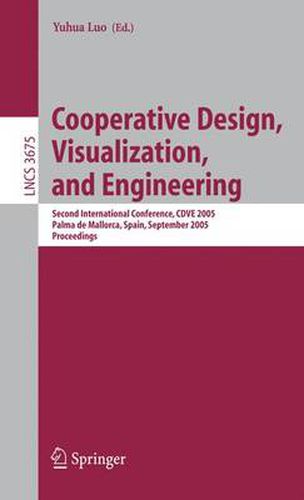Readings Newsletter
Become a Readings Member to make your shopping experience even easier.
Sign in or sign up for free!
You’re not far away from qualifying for FREE standard shipping within Australia
You’ve qualified for FREE standard shipping within Australia
The cart is loading…






This title is printed to order. This book may have been self-published. If so, we cannot guarantee the quality of the content. In the main most books will have gone through the editing process however some may not. We therefore suggest that you be aware of this before ordering this book. If in doubt check either the author or publisher’s details as we are unable to accept any returns unless they are faulty. Please contact us if you have any questions.
After one year, the major actors in the ?eld of cooperative design, visualization and engineering gathered together again by the side of the beautiful Medit- ranean Sea to exchange the research and development experience in the ?eld. CDVE2005servedasaforumtopromotetheresearchinthe?eldanditattracted greatattentionfromthe CDVE community.Thisyear,wereceivedcontributions from over 100 authors, 5 continents and more than 20 countries. As we can see, great progressin researchand development has been achieved since the last conference. We received papers on cooperative design, cooperative visualization, cooperative engineering and other cooperative applications. As an important trend, the researchers have started to attack the problems in CDVE from a more generic base. We are happy to see contributions such as constraint maintenance,decisionsupport,andsecurityenforcementforCDVE.Casestudies and application-speci?c developments are among the cooperative visualization papers. Along the line of cooperative engineering, knowledge management, - con?gurability, and concurrency control are major issues being addressed. Cooperativeworkingin design,visualization,engineering andother areashas di?erent degrees of cooperation. I classify them as strong cooperation, inter- diate cooperation, and light cooperation. Strong cooperation involves real-time multiple-user multiple-location modi?cation to the same workspace.Light co- eration exists in the applications where the basic working relationship is only information or workspace sharing among the cooperative entities, no mod- cation to the workspace is involved. Therefore, any application that is shared by more than one single user can be considered as a light-degree cooperative application. Any application between these two extremes can be considered as intermediately cooperative. Our conference addressed the common and speci?c issues of all of them.
$9.00 standard shipping within Australia
FREE standard shipping within Australia for orders over $100.00
Express & International shipping calculated at checkout
This title is printed to order. This book may have been self-published. If so, we cannot guarantee the quality of the content. In the main most books will have gone through the editing process however some may not. We therefore suggest that you be aware of this before ordering this book. If in doubt check either the author or publisher’s details as we are unable to accept any returns unless they are faulty. Please contact us if you have any questions.
After one year, the major actors in the ?eld of cooperative design, visualization and engineering gathered together again by the side of the beautiful Medit- ranean Sea to exchange the research and development experience in the ?eld. CDVE2005servedasaforumtopromotetheresearchinthe?eldanditattracted greatattentionfromthe CDVE community.Thisyear,wereceivedcontributions from over 100 authors, 5 continents and more than 20 countries. As we can see, great progressin researchand development has been achieved since the last conference. We received papers on cooperative design, cooperative visualization, cooperative engineering and other cooperative applications. As an important trend, the researchers have started to attack the problems in CDVE from a more generic base. We are happy to see contributions such as constraint maintenance,decisionsupport,andsecurityenforcementforCDVE.Casestudies and application-speci?c developments are among the cooperative visualization papers. Along the line of cooperative engineering, knowledge management, - con?gurability, and concurrency control are major issues being addressed. Cooperativeworkingin design,visualization,engineering andother areashas di?erent degrees of cooperation. I classify them as strong cooperation, inter- diate cooperation, and light cooperation. Strong cooperation involves real-time multiple-user multiple-location modi?cation to the same workspace.Light co- eration exists in the applications where the basic working relationship is only information or workspace sharing among the cooperative entities, no mod- cation to the workspace is involved. Therefore, any application that is shared by more than one single user can be considered as a light-degree cooperative application. Any application between these two extremes can be considered as intermediately cooperative. Our conference addressed the common and speci?c issues of all of them.